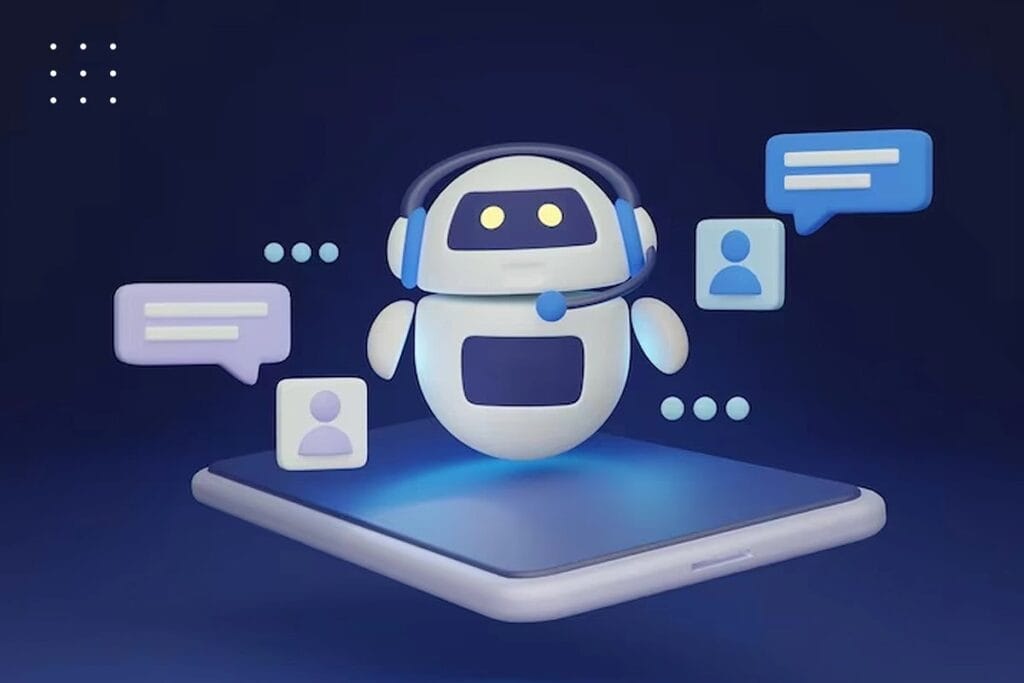Voice Over Internet Protocol (VoIP) and artificial intelligence (AI) are some of the fastest-developing technologies. AI has changed every aspect of business operations and daily life, while VoIP is revolutionizing communication.

Both of these technologies have exhibited their potential to be breakthrough innovations in modern business and market structure. So, integrating the power of AI with the advantages of VoIP seems to be a match made in heaven, facilitating every aspect of seamless and affordable communication.
Considering their capabilities, we can anticipate many changes in the future. So, let’s learn how VoIP and AI are revolutionizing communication.
Brief Overview of VoIP (Voice over Internet Protocol) and AI (Artificial Intelligence)

Voice Over Internet Protocol (VoIP) is an Internet telephony technology or virtual phone system that enables users to make and receive voice calls via the Internet.
To be more specific, it means that while using VoIP, the users do not require a telephone line, physical infrastructure, or hardware. Users can make and receive calls from anywhere in the world, they just need a device that supports internet connectivity and a good internet connection.
We can consider VoIP to be the future of the telephony sector as it offers some of the best benefits, including scalability, flexibility, mobility, cost savings, and many more.
On the other hand, Artificial Intelligence (AI), refers to a set of sophisticated processes using computer systems and machine learning to replicate human capabilities into machines, robots, and other devices. In other words, AI can be defined as a process that involves creating computer programs that can perform human tasks without any human interaction.
AI deals with various factors like natural language processing (NLP), which understands human language and performs interaction, learning from past transactions or experiences, known as Machine learning, recognizing patterns, solving problems, and making decisions.
Importance of Communication in Today’s World
Communication has been an important part of human civilization since the beginning. The importance of communication is always increasing. From connectivity to information sharing, communication has become very crucial in today’s world. Here are some of its benefits:
- Data and Information Sharing: Communication is the medium for sharing data and information. It is a primary means by which ideas, opinions, views, and various updates are shared between people.
- Global Outreach: Today’s time is known as the time of globalization and digitalization. Communication plays a vital role in globalizing the world by removing geographical barriers and enabling people to exchange information from one place in the world to another, be it different cities or nations.
- Personal and Professional Relationships: Communication is vital for maintaining a good personal and professional relationship. Whether it be formal and professional relationships or family, friends, or other relationships, open communication is very important.
- Business: Communication is also very important in business. Moreover, considering the current market structure and competition, effective communication is an inevitable part of a successful business.
Communication is needed in daily operations, marketing, sales, and every other function within the business.
- Innovation and Collaboration: Furthermore, innovation and technological advancements are being conducted at a rate that has never been seen before.
In such a time of technological revolution, communication is an integral part of innovation and collaboration. Innovation requires connection, collaboration, teamwork, and information sharing, which can only be possible through efficient communication.
Furthermore, communication is important in various other sectors, including education, learning, healthcare, medicine, social change, cultural exchange, decision-making, problem solving, and many more.
VoIP Revolutionizing Communications

Voice Over Internet Protocol (VoIP) is an Internet telephony technology or virtual phone system that enables users to perform voice communication or share multimedia with the help of the Internet and a device that supports the Internet, like smartphones, tablets, laptops, and desktop computers.
VoIP can be considered the future of Telephony communication, as it has revolutionized communication to a great extent. Here is how VoIP has revolutionized communication and its benefits.
- Cost Saving
Traditional phone systems use physical phone lines, which can incur additional costs for making and receiving calls. Likewise, setting up a traditional telephone system also requires physical infrastructure, and hardware installations like private branch exchanges (PBX). Investing in all these factors can be very expensive for any business.
On the other hand, VoIP enables voice communication via the Internet, eradicating the need for physical lines, hardware, and infrastructure, helping businesses save a lot of money on communication. Moreover, using a virtual phone system significantly reduces long-distance and internet costs by removing any additional costs.
- Scalability
Scaling the traditional phone system is complex and time-consuming, as rewiring, hardware installation, and setup are required. However, businesses can seamlessly increase or decrease the number of users and the plan based on needs and requirements.
- Flexibility
The business world and the market structure have changed at an unprecedented rate and have given rise to a modern workforce of remote and mobile workers. Implementing a remote and mobile workforce with a traditional phone system is impossible.
In such cases, businesses can opt for a virtual phone system that enables employees to make and receive calls from anywhere. Employees just need a device and a good internet connection.
- Advanced Features
With a virtual phone system, you are not limited to making and receiving calls. VoIP comes with a number of advanced features. For example, you can use features like call routing, forwarding, monitoring, recording, video calling, conference calling, interactive voice response (IVR), etc.
Moreover, some providers even offer features like unified communications and voicemail-to-email transcription.
- Integration
Last but not least, using VoIP allows you to integrate your communication with various tools like Customer Relationship Management (CRM) and helpdesk. This enhances and streamlines business communication within and outside the business.
AI Revolutionizing Communications

The introduction of AI has changed the way we communicate. Factors like Natural Language Processing (NLP), which deals with understanding human language and performing interaction and speech recognition, have resulted in more efficient and seamless communication.
- Natural Language Processing (NLP)
Natural language processing (NLP) is a technology that understands human language and interacts with it. It includes interpretation and translation of the language.
Currently, NLP is able to perform very complex tasks like sentiment analysis, where AI can interpret emotion and opinion by analyzing the data. Most likely, they are also able to perform tasks like language generation.
- Speech Recognition and Synthesis
AI is capable of performing speech recognition and synthesis. Speech recognition is the ability of AI that allows it to translate spoken language into text. Speech recognition can be a game-changer in communication as it can facilitate virtual assistants, language translation, real-time transcription, automated customer service, and voice commands.
On the other hand, Speech Synthesis is the ability of AI to understand and create human-like speech from written text.
There are many applications of synthesis, like voice assistants and Navigation Systems like GPS, which use speech synthesis to give instructions and directions. Likewise, it can be used for language learning by foreigners and students. Finally, it can be used to make Automated Announcements when human interactions are not required.
- Chatbots and Virtual Assistants
Finally, the development of AI has given rise to advanced chatbots and virtual assistants. Chatbots and virtual assistants have enhanced customer service significantly.
They provide instant responses to customer queries on websites and social media. Likewise, Virtual assistants like Siri, Google Assistant, and Alexa offer personalized service to users. Nowadays, chatbots are used to automate repetitive and monotonous tasks that do not require any human interaction.
The Synergy of VoIP and AI
Integrating VoIP technologies and AI can significantly improve seamless communication, the user experience, and service quality. For example, the ability of VoIP to perform voice communication over the internet can be automated or intelligently dealt with with the help of AI.
AI can process, interpret, and use the data generated by VoIP systems, to offer some of the most advanced features. The synergy that results from the combination of these two technologies improves not only communication processes but also interactions between people and businesses.
Here are some ways in which the synergy between VoIP communication and AI can be used successfully.
- Smart Call Routing
With the help of AI and VoIP integration, businesses can perform smart call routing. This will ensure that the call is directed to the right person, department, or branch based on the needs.
AI can go through the database, analyze the caller ID for their preferences, and context, and route the call. This leads to a decrease in waiting time, seamless communication, and better customer satisfaction.
- Real-time Language Translation
Voice over IP can transmit calls globally and integrate AI-powered language translation for real-time translation. The result is seamless communication between people speaking different languages, fostering collaboration and understanding across the globe.
This feature can be great for businesses that operate internationally and have a huge number of foreign customers. Furthermore, it can help in cost reduction for the business as they do not have to maintain separate human resources for translation.
- AI-driven Customer Support
Last but not least, the integration of AI and VoIP can help in AI-driven customer support. Chatbots and virtual assistants can be integrated into VoIP-based customer support systems.
With AI agents, customers can ask questions, receive information, and even troubleshoot common issues, which enhances customer service. This ensures accuracy and better customer service.
Conclusion
The combination of VoIP and AI is changing communication for the better. VoIP offers a number of benefits including cost savings, scalability, and flexibility, while AI brings automation, advanced language processing, and virtual assistants.
This integration is already reshaping communication but with the ongoing research and development, we can anticipate more drastic changes in the future.











